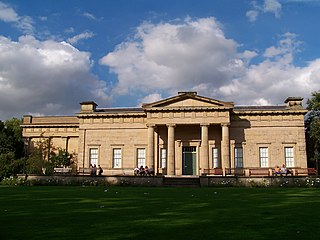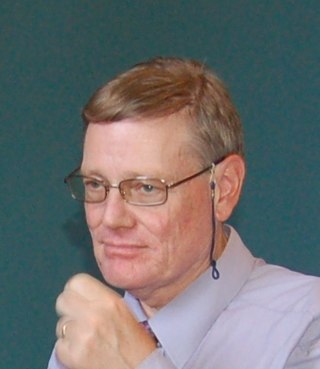Related Research Articles
Michael Hewson Crawford, is a British ancient historian and numismatist. Having taught at Christ's College, Cambridge and the University of Cambridge, he was Professor of Ancient History at University College London from 1986 until he retired in 2005.
Robert Andrew Glendinning Carson, FBA was a British numismatist.

Charles Roach Smith, FSA, was an English antiquarian and amateur archaeologist who was elected a fellow of the Society of Antiquaries of London, and the London Numismatic Society. He was a founding member of the British Archaeological Association. Roach Smith pioneered the statistical study of Roman coin hoards.

The Numismatic Museum of Athens is one of the most important museums in Greece and it houses a collection of over 500,000 coins, medals, gems, weights, stamps and related artefacts from 1400BC to modern times. The collection constitutes one of the richest in the world, paralleled by those of the British Museum in London, the Bibliothèque Nationale in Paris, the State Hermitage Museum in St. Petersburg, the Bode Museum in Berlin, and the American Numismatic Society in New York. The museum itself is housed in the mansion of the archaeologist Heinrich Schliemann, formally known as Iliou Melathron.

The Yorkshire Museum is a museum in York, England. It was opened in 1830, and has five permanent collections, covering biology, geology, archaeology, numismatics and astronomy.
The Cunetio Hoard, also known as the Mildenhall Hoard, is the largest hoard of Roman coins found in Britain. It was discovered in 1978 at the site of the Roman town of Cunetio, near modern-day Mildenhall, Wiltshire, and consisted of 54,951 low value coins. The coins were contained in a large pot and a lead container. The coins are now in the British Museum and the pot is on display at the Wiltshire Museum in Devizes.
Agnes Baldwin Brett was an American numismatist and archaeologist who worked as the Curator at the American Numismatic Society from 1910 to 1913. She was the first paid curator at the American Numismatic Society. She made important contributions to the study of ancient coinage, medals, and sculpture, whose work was used by later archaeologists. Brett was also a visiting lecturer of archaeology at Columbia University in 1936.
Anne Strachan Robertson FSA FSAScot FRSE FMA FRNS was a Scottish archaeologist, numismatist and writer, who was Professor of Roman Archaeology at the University of Glasgow and Keeper of the Cultural Collections and of the Hunterian Coin Cabinet at the Hunterian Museum. She was recognised by her research regarding Roman Imperial coins and as "a living link with the pioneers of archaeological research".
The Hospital of the Holy Innocents, or the Melandry was a Leper Hospital on South Park common in Lincoln, England. It was founded in the late 11th or early 12th century either by Bishop Remigius or Henry I. It was possibly the first Leper Hospital to be founded in England. In 1422 the confraternity of Burton Lazars was granted the Hospital of the Holy Innocents. At the time of Dissolution of the Monasteries, the Hospital, together with the Burton Lazars hospital were purchased by William Cecil, 1st Baron Burghley

Roger Farrant Bland, is a British curator and numismatist. At the British Museum, he served as Keeper of the Department of Portable Antiquities and Treasure from 2005 to 2013, Keeper of the Department of Prehistory and Europe from 2012 to 2013, and Keeper of the Department of Britain, Europe and Prehistory from 2013 to 2015. Since 2015, he has been a visiting professor at the University of Leicester and a Senior Fellow of the McDonald Institute for Archaeological Research, University of Cambridge.
Robert Anthony "Tony" Merson (1950–2016) was a British numismatist and philatelist, with a particular interest in the coins of medieval France.
Andrew R. Woods is a British numismatist, archaeologist and curator specialising in early medieval and Viking coinage. He is the senior curator of the Yorkshire Museum and was formerly the curator of numismatics at the York Museums Trust.

Elizabeth Jean Elphinstone Pirie was a British numismatist specialising in ninth-century Northumbrian coinage, and museum curator, latterly as Keeper of Archaeology at Leeds City Museum from 1960 to 1991. She wrote eight books and dozens of articles throughout her career. She was a fellow of the Royal Numismatic Society, president of the Yorkshire Numismatic Society and a fellow of the Society of Antiquaries of London.

The Hexham hoard is a 9th-century hoard of eight thousand copper-alloy coins of the Anglo-Saxon Kingdom of Northumbria, which were discovered whilst a grave was being dug close to Hexham Abbey in 1832.

The Kirkoswald Hoard is a ninth-century hoard of 542 copper alloy coins of the Kingdom of Northumbria and a silver trefoil ornament, which were discovered amongst tree roots in 1808 within the parish of Kirkoswald in Cumbria, UK.
The St Leonard's Place hoard was a hoard of c. 10,000 early medieval Northumbrian coins known as stycas, discovered by workers during construction work at St Leonard's Place in York in 1842. Many of the coins were subsequently acquired by the Yorkshire Museum.
References
- ↑ Robertson, A.S. (2000). An Inventory of Romano-British Coin Hoards. Royal Numismatic Society Special Publication 20. Royal Numismatic Society. p. 12.
- 1 2 Thorp, F. (1976). "The Yorkshire Archaeological Register 1975". Yorkshire Archaeological Journal. 48: 5.
- ↑ Tilley, Emily, ed. (2018). Old Collections, New Questions: Researching the Roman Collections of the Yorkshire Museum (PDF) (Report). Yorkshire Museum. p. 92.